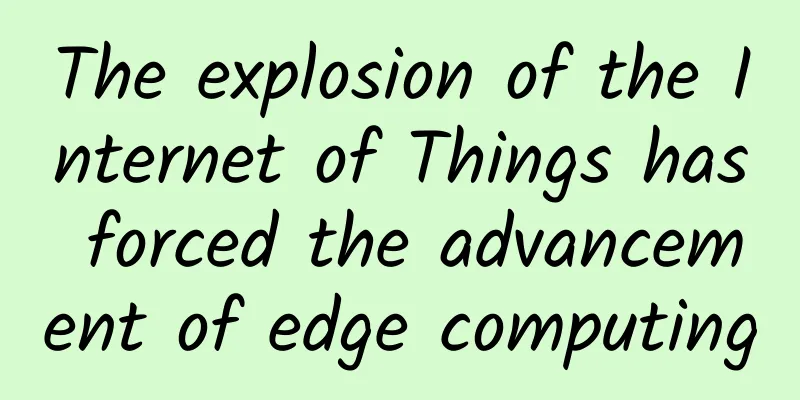The explosion of the Internet of Things has forced the advancement of edge computing

|
According to research firm IDC, spending on the Internet of Things (IoT) will reach $1.3 trillion by 2020, with 43% of the world's data being processed at the edge. The research firm predicts that there will be 30 billion IoT devices by 2020 and jump to 80 billion in the next 25 years. This market demand is driving the need for new solutions such as edge computing. Historically, the dominant view in the IT industry has oscillated between a centralized model and a decentralized model. It started with centralized mainframe computing, then moved to decentralized client-server networks, and then back again to a centralized model in the cloud. Now, the time has come for this decentralized model in the form of “local edge computing.” The decentralized model will become essential as IT infrastructure is required to support IoT applications and devices (different from the requirements of traditional IT applications such as email and productivity apps). This doesn’t mean that cloud computing is going away. It will continue to process large amounts of data from traditional IT applications, and people will process much of the data for data science there, but it will remain for data that doesn’t require immediate attention or has different needs than traditional applications. However, anything that requires real-time decision making, such as smart medical devices that monitor patients and feed information back to medical staff, will likely be processed at the edge. Edge computing definition But what exactly is edge computing? Why must data be processed there? In short, in an enterprise's hybrid IT deployment, the local edge creates a high-performance bridge for the enterprise's external public cloud and/or private cloud, on-premises data center, co-located enterprise data center, and local on-premises IT deployment. Cloud platforms centralize data processing and storage, but as enterprises begin to adopt IoT facilities, many have realized that this centralization has its limitations and that certain applications simply cannot be properly supported. The Internet of Things aims to connect any device or person that can be connected via a network to generate a continuous flow of information that can help organizations reduce operating costs, increase revenue or improve customer experience. Edge computing is needed because many IoT applications require some combination of extremely low latency, high bandwidth, or rigorous data processing. Take the retail industry as an example: To improve foot traffic in physical stores, retailers are digitizing the customer experience by adopting emerging technologies such as digital signage, digital wallets, augmented reality, smart fitting rooms, etc., while optimizing cost structures through digital supply chains. If the data used by these systems must be transmitted hundreds or thousands of miles to centralized cloud computing centers, the latency experienced will greatly affect the customer experience that retailers are trying to provide. That’s where edge computing is gaining momentum. It creates a network of localized sites that process data as close to the person or device as possible, greatly reducing or eliminating latency, bandwidth, and data processing issues. So, as we look ahead to this brave new world of IoT and edge computing, we will see a combination of cloud computing, regional data centers, and localized edge computing that will ideally work in harmony to produce better business outcomes and bring certainty to the connected world. These outcomes will depend on the needs of the organization, but optimizing operational processes, increasing revenue, and improving customer experience are usually top of the list. Any business looking to leverage IoT technology needs to understand edge computing and identify the new efficiencies this decentralized approach can bring to its operations. |
<<: The Internet’s “high-salary list” has been revealed, will the Internet of Things take over?
>>: Compared with IPv4, IPv6 is more than just an increase in address length
Recommend
spinservers: $109/month - 2*E5-2650L v3 CPU, 64G memory, 1.6T SSD hard disk, 10TB/10Gbps, San Jose data center
If you need a high-end server, you can also take ...
How to integrate network management tools
In the process of curbing the proliferation of ne...
Top 10 technology trends governments should watch in 2021
[[391593]] The pandemic has forced government age...
VULTR adds 32nd data center in the world: Tel Aviv, Israel
In February this year, we shared the news that VU...
DigitalOcean: AMD EPYC+NVMe series are all online, and 8 computer rooms support hourly billing
The tribe has not shared information about Digita...
Dish Network plans to acquire Republic Wireless
According to foreign media, Dish Network announce...
New infrastructure becomes the biggest driving force for China's data center industry in 2020
In recent years, China has been comprehensively d...
From trials to use cases, the big 5G stories of 2017
In 2017, 5G gradually moved from the laboratory t...
Netty - Sticky Packets and Half Packets (Part 2)
Continue from the previous article "Introduc...
How NFV and SDN will shape the future of telecommunications
The Internet has been developed for decades. Face...
Which industry will be the hot spot for artificial intelligence in the 5G era?
In this process, many applications are constantly...
Scenario-based × disruptive innovation: polishing the minimalist "light" with users
[[423919]] "Users asked for an optical netwo...
WiFi 6 Blowout Begins
Despite the current epidemic, Xiaomi released a W...
MU-MIMO technology: the key to turning slow networks into lightning-fast ones
In recent years, with the rapid development of wi...
How can the chip industry survive in the era of the Internet of Things?
After the industrial revolution, the computer age...









